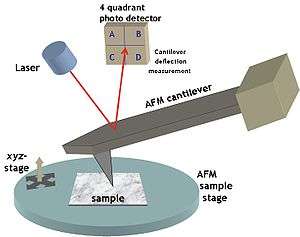Feature-oriented scanning
%2C_Fig._1.png)
Feature-oriented scanning (FOS), also object-oriented scanning (OOS), is a method of precision measurement of surface topography with a scanning probe microscope in which surface features (objects) are used as reference points for microscope probe attachment.[1][2][3] With FOS method, by passing from one surface feature to another located nearby, the relative distance between the features and the feature neighborhood topographies are measured. This approach allows the microscope to scan an intended area of a surface by parts and then reconstruct the whole image from the obtained fragments.
Topography
Any topography element that looks like a hill or a pit in wide sense may be taken as a surface feature. Examples of surface features (objects) are: atoms, interstices, molecules, grains, nanoparticles, clusters, crystallites, quantum dots, nanoislets, pillars, pores, short nanowires, short nanorods, short nanotubes, viruses, bacteria, organelles, cells, etc.
FOS is designed for high-precision measurement of surface topography (see Fig.) as well as other surface properties and characteristics. Moreover, in comparison with the conventional scanning, FOS allows obtaining a higher spatial resolution. Thanks to a number of techniques embedded in FOS, the distortions caused by thermal drifts and creeps are practically eliminated.
Applications
FOS has the following fields of application: surface metrology, precise probe positioning, automatic surface characterization, automatic surface modification/stimulation, automatic manipulation of nanoobjects, nanotechnological processes of "bottom-up" assembly, coordinated control of analytical and technological probes in multiprobe instruments, control of atomic/molecular assemblers, control of probe nanolithographs, etc.
Feature-oriented positioning
Feature-oriented positioning (FOP) is a method of precise movement of the scanning microscope probe across the surface under investigation. With this method, surface features (objects) are used as reference points for microscope probe attachment. Actually, FOP is a simplified variant of the feature-oriented scanning. With FOP, no topographical image of a surface is acquired. Instead, a probe movement by surface features is only carried out from the start surface point A (neighborhood of the start feature) to the destination point B (neighborhood of the destination feature) along some route that goes through intermediate features of the surface. The method may also be referred to by another name: object-oriented positioning (OOP).
To be distinguished are a "blind" FOP when the coordinates of features used for probe movement are unknown in advance and FOP by existing feature "map" when the relative coordinates of all features are known, for example, in case they were obtained during preliminary FOS. Probe movement by a navigation structure is a combination of the above-pointed methods.
FOP method may be used in bottom-up nanofabrication to implement high-precision movement of the nanolithograph/nanoassembler probe along the substrate surface. Moreover, once made along some route, FOP may be then exactly repeated the required number of times. After movement in the specified position, an influence on the surface or manipulation of a surface object (nanoparticle, molecule, atom) is performed. All the operations are carried out in automatic mode. With multiprobe instruments, FOP approach allows the application of any number of specialized technological and/or analytical probes successively to a surface feature/object or to a specified point of the feature/object neighborhood. That opens a prospect for building a complex nanofabrication consisting of a large number of technological, measuring, and checking operations.
See also
References
- ↑ Lapshin, Rostislav V (2004). "Feature-oriented scanning methodology for probe microscopy and nanotechnology". Nanotechnology. 15 (9): 1135–1151. Bibcode:2004Nanot..15.1135L. doi:10.1088/0957-4484/15/9/006. ISSN 0957-4484.
- ↑ Savio, E.; Marinello, F.; Bariani, P.; Carmignato, S. (2007). "Feature-Oriented Measurement Strategy in Atomic Force Microscopy". CIRP Annals. 56 (1): 557–560. doi:10.1016/j.cirp.2007.05.133. ISSN 0007-8506.
- ↑ Lapshin, R. V. (2011). "Feature-Oriented Scanning Probe Microscopy" (PDF). Encyclopedia of Nanoscience and Nanotechnology. 14: 105–115. Retrieved 2017-11-14.
